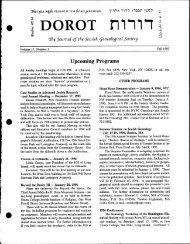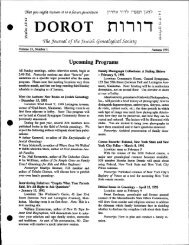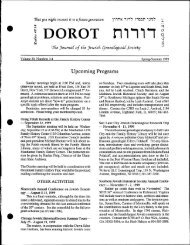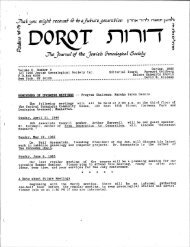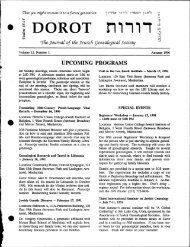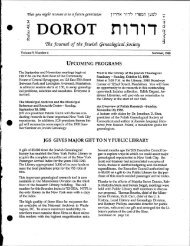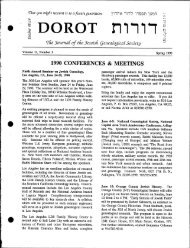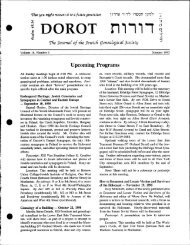24:3-4 Spring-Summer 2003 - Jewish Genealogical Society
24:3-4 Spring-Summer 2003 - Jewish Genealogical Society
24:3-4 Spring-Summer 2003 - Jewish Genealogical Society
You also want an ePaper? Increase the reach of your titles
YUMPU automatically turns print PDFs into web optimized ePapers that Google loves.
<strong>Genealogical</strong> Projects of the Israel <strong>Genealogical</strong> <strong>Society</strong><br />
Prepared for the <strong>24</strong>th IAJGS International Conference on <strong>Jewish</strong> Genealogy<br />
Jerusalem, July 4-9, 2004<br />
by Mathilde A. Tagger<br />
The conference organizing committee has decided to<br />
undertake several projects of indexing sources, to be<br />
ready for the IAJGS conference. It is hoped that these<br />
projects will constitute an important addition to the existing<br />
genealogical resources that are found in Israel in<br />
general and in her capital Jerusalem in particular. I hope<br />
with all my heart that the present summary of these special<br />
activities will prompt you to want to come to Jerusalem<br />
even more and to participate in this fabulous conference.<br />
The Memorials to the Vanished Communities<br />
Prepared by Ellen Stepak, Chana Furman, Rose Feldman<br />
and other Volunteers<br />
Memorials to the Vanished Communities<br />
are found primarily in the cemeteries<br />
of Israel, particularly in that of<br />
Holon (near Tel Aviv), which contains<br />
some 300 monuments. Although they<br />
are generally grouped in certain areas,<br />
one also finds them scattered<br />
throughout. These monuments commemorate<br />
one or several communities,<br />
sometimes of an entire region or country,<br />
such as the Memorial to Hungary on<br />
which the names of all the <strong>Jewish</strong> communities<br />
of that country are engraved. The names<br />
of tiny villages, otherwise forgotten by history, are sometimes<br />
found in the inscriptions. The most impressive<br />
monument is certainly the one dedicated to the memory<br />
of the community of Wlodawa (Poland) and the surrounding<br />
localities, in memory of victims of the death<br />
camp of Sobibor. The memorial may appear as a forest<br />
planted in memory of the victims. This is the theme chosen<br />
for Belgium, Estonia, France and Latvia.<br />
These memorials were erected with profound<br />
affection in memory of loved ones who disappeared during<br />
the Shoah, martyrs–victims of pogroms who found<br />
their deaths without the right to even the simplest grave.<br />
Numerous monuments are superlative. Moved by intense<br />
emotions, the architects were able to transfer them into a<br />
remarkable creation. There is one common feature–they<br />
all possess an urn containing ashes brought back from<br />
the collective killing fields or from the death camps scattered<br />
throughout Eastern Europe. On some monuments,<br />
one can find a list of names of the victims engraved. The<br />
majority of these memorials is dedicated to the communities<br />
of Poland, Ukraine, Lithuania and Belarus.<br />
The Israeli associations of people from a same<br />
community or region, known by their Yiddish name of<br />
landsmanschaftn, each year organize commemorative<br />
ceremonies at their respective memorials. However, the<br />
number of survivors originating in these communities is<br />
diminishing year by year, so that over the past several<br />
years these annual commemorations have become more<br />
and more rare.<br />
The database will be published on a CD-ROM<br />
in time for the International Conference of July 2004,<br />
and for each memorial it will include: one or several<br />
color photographs; the names of the communities such<br />
as they are inscribed in Hebrew letters with a transliteration<br />
in Latin letters; the modern names based<br />
upon Where Once We Walked* and upon<br />
ancient maps accompanied by the name<br />
of the province or gubernia and of the<br />
country according to actual boundaries;<br />
date of the annual commemorations;<br />
exact coordinates to the<br />
memorial (name of the cemetery,<br />
zone and section), and finally a comments<br />
column. At this time, a list of<br />
some 1,300 indexed communities can<br />
be found on the Internet site of our<br />
Association: www.isragen.org/ROS/<br />
mvc-1.html. Thanks to the details noted,<br />
those who wish to gather at one of these memorials<br />
will be able to find it easily.<br />
*Where Once We Walked. By Sallyann Amdur Sack and<br />
Gary Mokotoff. Avotaynu, <strong>2003</strong>. 2nd edition.<br />
The last population census ordered by Sir<br />
Moses Montefiore in 1875<br />
Prepared by Meriam Haringman and Jean-Pierre Stroweis<br />
The population census of the Jews residing in<br />
the Holy Land in 1875 is the last of a series of five censuses<br />
ordered by Sir Moses Montefiore and carried out<br />
in the course of the 19th century, starting in 1839. This<br />
is the first time in history that one of these censuses has<br />
been entirely deciphered, transcribed, translated, indexed<br />
and computerized.<br />
For the Ashkenazi part of the population, the<br />
census was done according to Kolel (Talmudic school).<br />
These Kolelim (plural of Kolel) carry the names of the<br />
communities where the students originally came from,<br />
Dorot • <strong>Spring</strong>-<strong>Summer</strong> <strong>2003</strong> -15-





